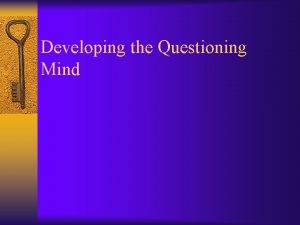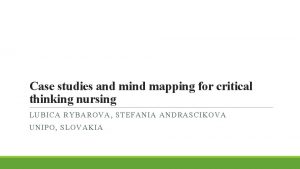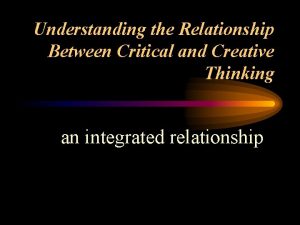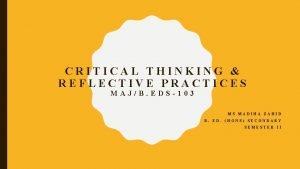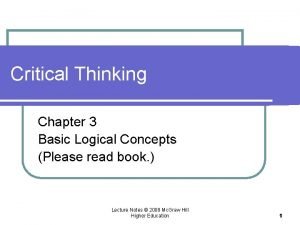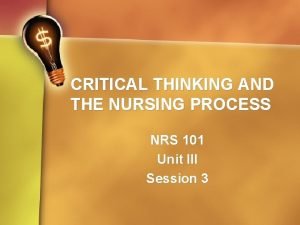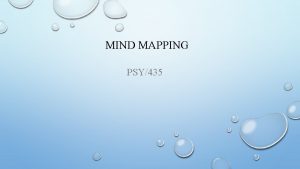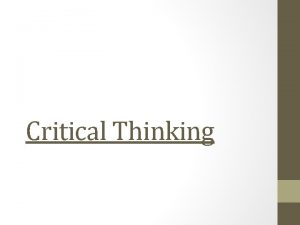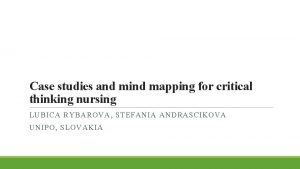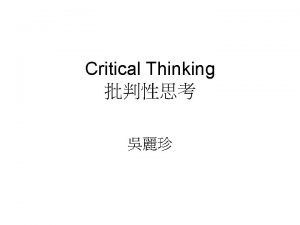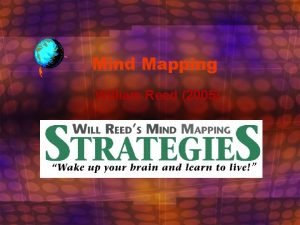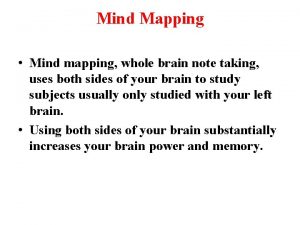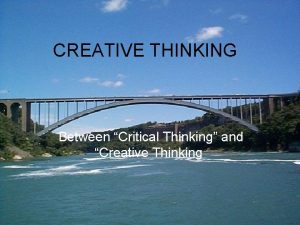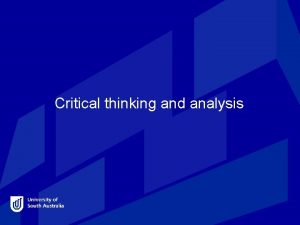Case studies and mind mapping for critical thinking















- Slides: 15

Case studies and mind mapping for critical thinking nursing LUBICA RYBAROVA, STEFANIA ANDRASCIKOVA UNIPO, SLOVAKIA

Concept - mind mapping § Mapping makes the use of graphics and designs to understand complex relationships and possible outcomes of these relationships. § In a nursing environment, it can help students connect conditions with treatments and potential side effects. § Mind mapping joins the critical thinking (CT) and case –based learning (CBL) and press on to student make a visual scheme how to solve the patient problem § Concept and problem mapping can develop the ability to see problems in their mind’s eye and improve creative thinking ability of students. § Nursing practice often calls for innovative thinking from practitioners and concept mapping can train students to meet this requirement. § Mapping can be applied with equal effectiveness to both - individuals and groups.

Definition Concept-mapping has been identified as a stimulating learning method to facilitate critical thinking by encouraging students to connect new knowledge to their prior learning, and to give students an opportunity to gain further, wide and varied knowledge of a number of concepts in a short period (Akinsanya & Williams 2004).

Concept / mind mapping and critical thinking § If students can link new information to their existing conceptual framework, they can construct new, meaningfull interconnections § Their existing conceptions are transformed, enriched or revised and conceptual change occurs. § Existing conceptions are transformed during knowledge construction, that is, construction of understanding. § Interaction, collaboration, cooperation, dialogue and discourse are key concepts in facilitating understanding of educational activities (promote teacher-student and group discu §ssion) § Concept-mapping has proved to be one of the most challenging learning experiences that facilitate critical and creative thinking skills (Akinsanya & Williams 2004).

Concept/mind mapping as teaching methods § The concepts are graphical or pictorial arrangements that deal with a specific subject matter (All and Havens 1997). § They are useful tools in representing the structure of knowledge in a form that is psychologically compatible with the way in which human beings construct meaning. § A concept is a perceived regularity in events or objects, or records of events or objects, designated by a label. § Concept maps are graphical tools for organizaing and representing knowledge in networks of concepts and linking statements about a problem or subject (Novak & Canas 2006). § Concept maps include concepts, usually enclosed in circles or boxes of some type and relationships between concepts or propositions, indicated by a connecting line and linking words between concepts. § Concept-mapping as a teaching method to promote critical thinking is based on theoretical foundation laid down by educational psychologists (Ausubel 1963; Ausubel, Novak & Hanesian 1978).


Planning and implementation § The interactive constructing process is a dynamic, mutual, collaborative exchange of ideas, thoughts and feelings between a student and the learning environment, and between students themselves, in the quest to make meaning by constructing new knowledge and skills through interaction. § In their planning and implementation of a teaching method, nurse educators should be aware that students arrive at meaning by active selecting and accumulative constructing their own knowledge through interaction, rather than by receiving and storing knowledge. § A student brings an accumulated baggage of knowledge, skills, attitudes and values to a particular teaching and learning situation, and these form an important framework that envelopes the immediate learning situation. § This step requires the use of critical, creative, reflective and conceptualisation skills, which are regarded as higher thinking skills (Beyer 1988).

Process § The interactive constructing process can be facilitated through teaching methods that encourage dialogue and an interactive, collaborative discussion among students (Clarke, James and Kelly 1996). § During this process there should be critical analysis that reviews and links the previous knowledge with the new knowledge for learning to take place (Scanlan & Chernomas 1997). § This is a data-gathering step in which students should demonstrate critical thinking dispositions such as flexibility, willingness, open-mindedness, an inquiring mind analyticity in gathering data about the phenomenon (Facione 1990). § The cognitive skills of analysis, interpretation and inference play an integral part in this step.

Ways of creating maps

Evaluation and feedback § A concept map can be used as a visual framework for learning a selected learning area. § It can also be used as the basis for developing measures of understanding and displaying the results of the thinking process. § A concept map can be given a title and can be placed on Power. Point so that other students can view it and take the discussion further.

Revision Students should be encouraged to revise their concept maps. The development of reflective questions and an inquiring mind are integral to the facilitation of critical thinking. Questions such as the following are usually helpful: § Is the concept map clear? § Is it logically constructed? § Is the map accurate, attractive, thorough and well-assembled? § Does the map demonstrate creativity and imagination? § How do the concept and interlinking statements fit together? § Could it have been constructed differently? § What would have been the alternative approach to facilitating critical thinking through concept-mapping? § Does it make sense, is it meaningful? Why or why not? § Is there anything missing, unclear, or problematic about the map? § How does it fit with the student’s experience?

Benefits of Mind Maps § Help students brainstorm and explore any idea, concept, or problem § Facilitate better understanding of relationships and connections between ideas and concepts § Make it easy to communicate new ideas and thought processes § Allow students to easily recall information § Help students take notes and plan tasks § Make it easy to organize ideas and concepts

Advantages of Mind Maps § Mind maps work the way the brain works - which is not in nice neat lines. § Memory is naturally associative, not linear. Any idea probably has thousands of links in your mind. Mind maps allow associations and links to be recorded and reinforced. § The mind remembers key words and images, not sentences - try recalling just one sentence from memory! Mind maps use just key words and key images, allowing a lot more information to be put on a page. § Because mind maps are more visual and depict associations between key words, they are much easier to recall than linear notes. (For example, although you may not have studied it in depth, see how much of the Home Mind Map of this site you can recall in your mind's eye. ) § Starting from the center of the page rather than top-left corner allows you to work out in all directions. § The organization of a mind map reflects the way your own brain organizes ideas. § Mind maps are easy to review. Regular review reinforces memory. Best is to try reviewing in your imagination first, then go back and check on those areas that were hazy. § We remember what stands out (where were you when John Lennon was shot? ). Visual quality of mind maps allows you to make key points to stand out easily.

Conclusion § Concept maps are valuable tools to harness the power of learners’ vision to understand complex information at a glance. § Concept-mapping is a teaching method to facilitate creative, reflective and critical thinking. § Nurse educators are recommended to use concept-mapping to facilitate critical thinking and encourage a deep approach to learning. § Educators are urged to use concept-mapping as a method of individual or group assessment and evaluation to assess learners’ conceptual understanding and handling of complex information. § Educators can use concept-mapping to plan and revise curricula. § They should encourage learners to use concept-mapping to make summaries of large chunks of information. § Concept-mapping can also be used to plan some research activities and to plan a patient care. § It can be a valuable method to teach clinical nursing education – for example, nursing care of a patient with some diagnosis.

References and recommendation Akinsanya, C. & Williams, C. , 2004, ‘Concept-mapping for meaningful learning’, Nurse Education Today 24, 41− 46. https: //www. youtube. com/watch? v=8 s. Lrbw. TPc. ME Novak, J. D. , 2007, ‘Concept maps. What the heck is this? ’, viewed 12 September 2007, from http: //www. msu. edu/~luckie/ ctools/ http: //www. slideshare. net/guestcc 23 f 8 a/concept-mapping-for-the-slightly-confused All, A. & Havens, R. L. , 1997, ‘Cognitive/concept-mapping: A teaching strategy for nursing’, Journal of Advanced Nursing 25, 1210− 1219. http: //www. austincc. edu/adnfac/collaborative/onsite_conceptmap. htm Software Novak, J. D. & Canas, A. J. , 2006, ‘The theory underlying concept maps and how to construct them. Florida Institute for Human and Machine Cognition Pensacola FI, 32502’, viewed 20 September 2007, from http: // www. ihmc. us Mouton, J. , 1996, Understanding social research, JL van Schaik Publishers, Pretoria Ausubel, D. P. , 1963, The psychology of meaningful verbal learning, Grune and Stratton, New York. Ausubel, D. P. , Novak, J. D. & Hanesian, H. , 1978, Educational psychology: A cognitive view, 2 nd edn. , Holt, Rinehart & Winston, New York. Tikhomirov, O. , 1988, The psychology of thinking, Progress Publishers, Moscow. Beyer, B. K. , 1988, Developing a thinking skills program, Allyn and Bacon, London. Clarke, B. , James, C. & Kelly, J. , 1996, ‘Reflective practice: Reviewing the issue and refocusing the debate’, International Journal of Nursing Studies 33, 171− 180. Scanlan, J. M. & Chernomas, W. M. , 1997, ‘Developing the reflective teacher’, Journal of Advanced Nursing 25, 1138− 1143. Facione, P. A. , 1990, ‘Critical thinking: A statement of expert consensus for purpose of educational assessment and instruction’. Executive summary, The Delphi Report, California Academic Press, Millibrae. http: //www. xmind. net/download/win/ http: //mindview-3 -pro. soft 112. com/ http: //www. matchware. com/en/default. htm
 Critical semi critical and non critical instruments
Critical semi critical and non critical instruments Semi-critical
Semi-critical The critical mind is a questioning mind
The critical mind is a questioning mind Critical thinking mind map
Critical thinking mind map Perbedaan critical thinking dan creative thinking
Perbedaan critical thinking dan creative thinking Best worst and average case
Best worst and average case Asking and giving direction in hospital
Asking and giving direction in hospital Memory parameters
Memory parameters Forward mapping vs backward mapping
Forward mapping vs backward mapping Prinsip analisis dan desain
Prinsip analisis dan desain Relationship between critical and creative thinking
Relationship between critical and creative thinking Nursing process and critical thinking
Nursing process and critical thinking Critical thinking and reflective practices
Critical thinking and reflective practices Critical thinking chapter 2
Critical thinking chapter 2 Logic and critical thinking chapter 3
Logic and critical thinking chapter 3 Critical thinking attitudes in nursing
Critical thinking attitudes in nursing


